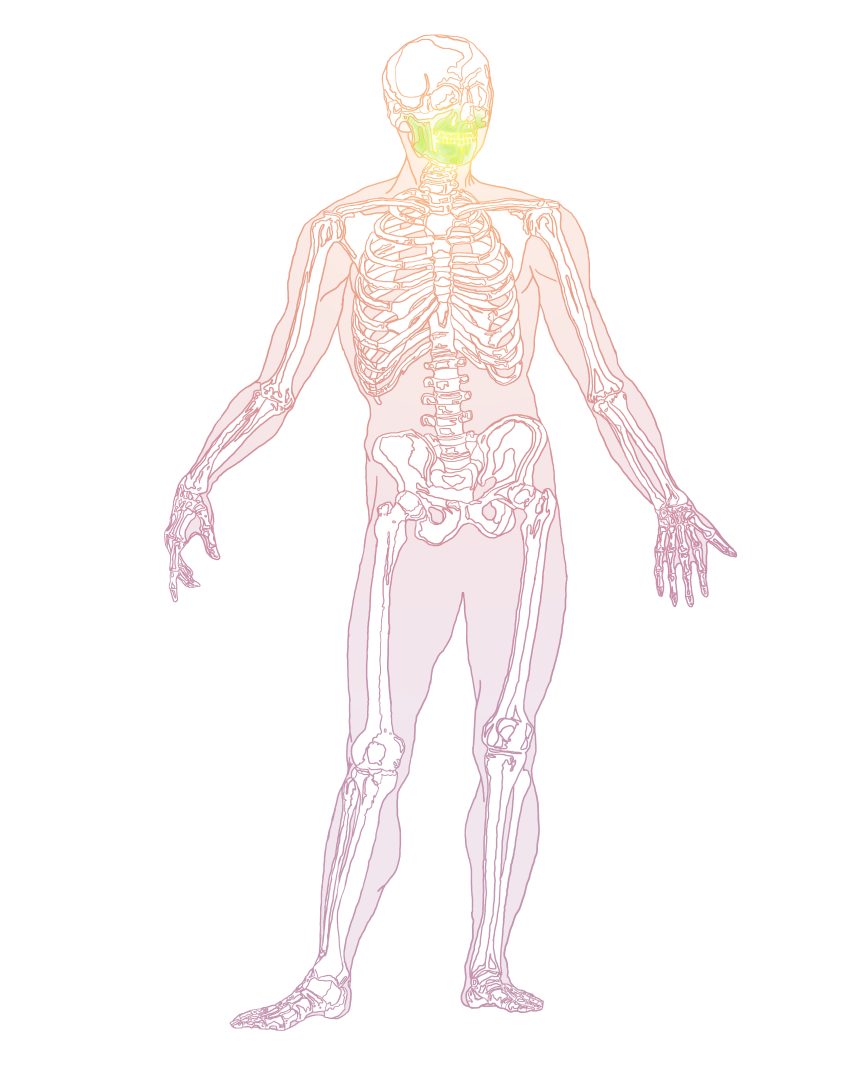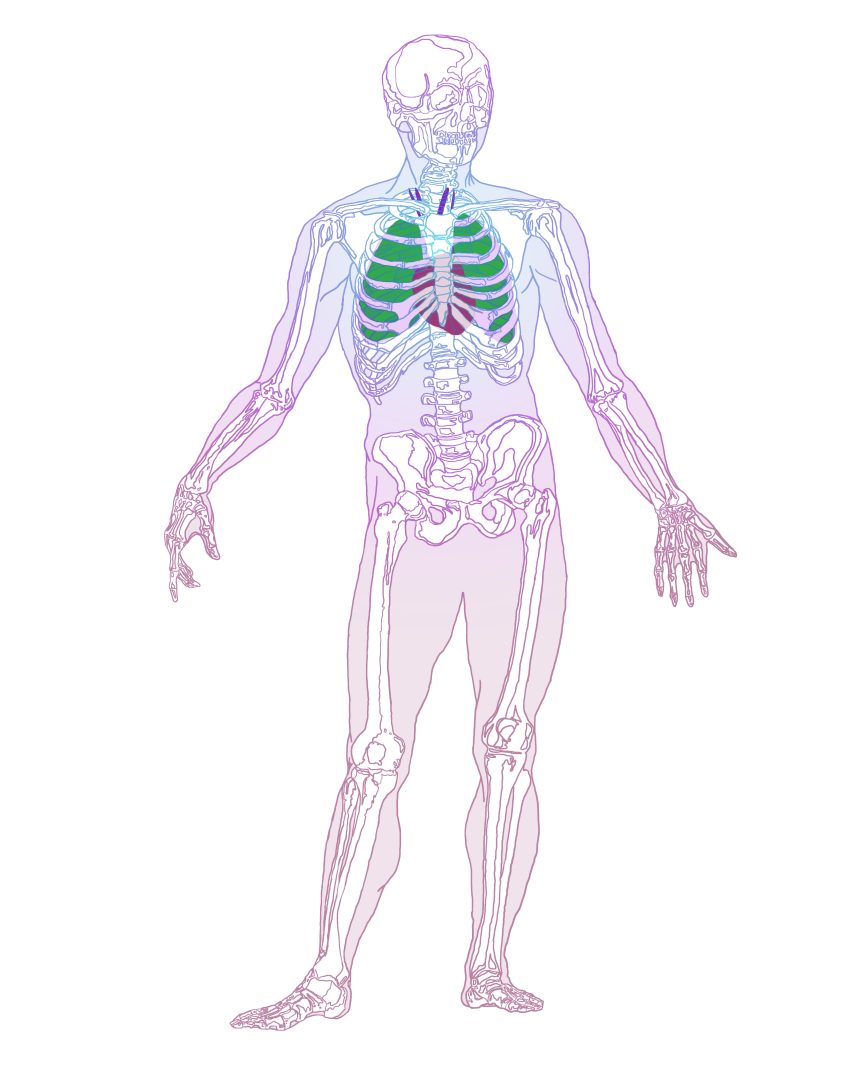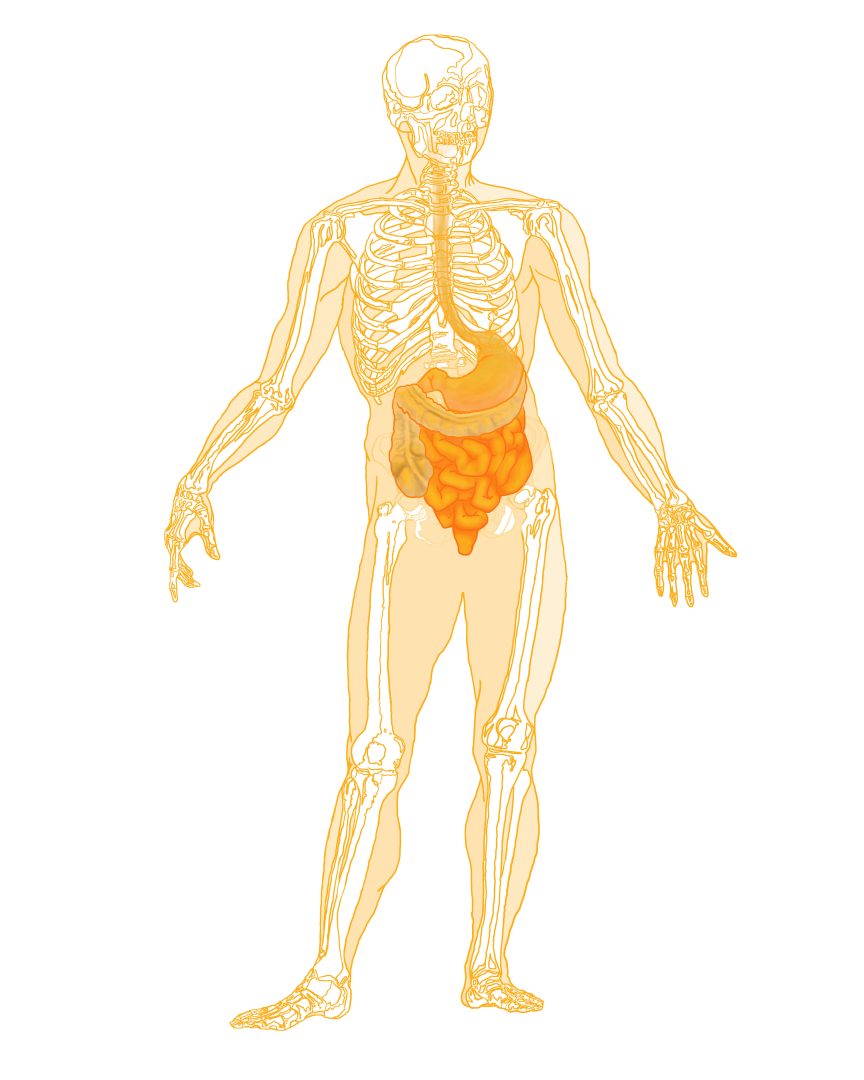Scleroderma, or systemic sclerosis, is a chronic connective tissue disease. It is generally classified as an autoimmune disease. The symptoms of scleroderma vary greatly from person-to-person, and not all people with scleroderma develop all complications. Symptoms of scleroderma may be visible, as is the case when the skin is affected, or the symptoms may be invisible, as when internal organ systems are affected.
If you have been diagnosed with a localized form of scleroderma, such as linear scleroderma or morphea, click here for more information.
The Vascular System is defined as the vessels and tissues that circulate blood in the body. The most common example of vascular system involvement in scleroderma is Raynaud Phenomenon. (See more by clicking on the hands).
A vascular disease is a condition that affects blood carrying vessels. Most often, vascular disease affects blood flow, either by blocking or weakening blood vessels, or by damaging the valves that are found in veins. Organs may be damaged by vascular disease as a result of decreased or blocked blood flow.
Endothelium is the layer of cells that cover the interior surface of the blood vessels. Scleroderma results in damage to these endothelium cells. The cause of this damage is currently unknown.
Not only is scleroderma a disease of vascular injury, it is also a disease of inadequate vascular repair. Once these vessels have been damaged it is difficult for an individual with scleroderma’s body to repair the damage. Vascular system damage is attributed to PAH (see more by clicking on lungs).
Learn More
Oral, Facial, and Dental Problems
People with scleroderma may experience a general tightening of skin over the face. The opening of the mouth may be decreased in size (microstomia or small mouth), making lip and mouth movements as well as oral hygiene difficult.
The best approach to treatment is by means of facial grimacing and mouth stretching exercises, including the use of oral augmentation props inserted between the upper and lower teeth. When doing these exercises, be careful to avoid further damage, especially to the jawbone and teeth. Particular care is advisable in using augmentation devices. Consult with your dentist before starting any exercises or using any augmentation device.
Preventive dental care including regular flossing and brushing of the teeth and gums is very important, as are regular dental visits for oral health and for the early detection and prompt correction of any abnormalities. The dentist also can recommend a good oral hygiene program. Floss holders, pump toothpaste tubes and built-up handles on toothbrushes can help people with hand impairment. (These measures are equally important for those with Sjögren Syndrome.)
Learn More
Raynaud Phenomenon
Raynaud Phenomenon is the most common early symptom of systemic scleroderma. It is present at one time or another in about 90 percent of patients. It is most obvious in the fingers and toes but can also involve the ears, nose, and tip of the tongue. In Raynaud Phenomenon, the blood vessels constrict or narrow in response to cold or emotional upset and stress. The resulting disturbance in blood circulation causes a series of color changes in the skin: white, blanched, or pale, when circulation is reduced; blue as the affected part loses oxygen from decreased blood flow; and then red or flushed as blood flow returns and the part re-warms. Finally, as the attack subsides, and the circulation returns to normal, usual skin color is restored. In the “white” or “blue” stages, sensations such as tingling, numbness and coldness may be felt. In the “red” stage, a feeling of warmth, burning or throbbing may be noted. Some people find Raynaud attacks painful.
Many common-sense preventive measures can be taken by those susceptible to Raynaud Phenomenon. Most obvious is minimizing exposure to cold, such as outdoor weather, air conditioning, or reaching into a refrigerator or freezer. Keeping your extremities and body warm is very important. Gloves or mittens should be worn, and a number of warming devices are available to protect the hands. Hats, earmuffs, heavy socks, and warm, layered clothing of made from silk, cotton, wool, and down feathers can help maintain body temperature. It is important to protect your hands with gloves when touching refrigerated or frozen items. Electric heaters, electric blankets and comforters can supplement the heat in the home or apartment. Keeping the entire body warm helps prevent Raynaud episodes. A warm bath or shower, or heating pad or hot water bottle on the back, may relieve an attack better than just warming the hands. Avoidance of emotional upset and stress can help but isn’t always possible. Many Various relaxation techniques, whether self-taught or learned through training courses, prove effective for some people to manage stress. One particular technique, biofeedback, has been used to increase finger temperature.
Smoking definitely worsens Raynaud Phenomenon. For this and other reasons, persons with scleroderma should not smoke.
When Raynaud Phenomenon does occur, carefully waving the arms in an underhand, circular motion (like a softball pitcher) can help to restore blood circulation. Rubbing or massaging the hands and feet may also help.
Physicians use a number of different medications to prevent, reduce the frequency or minimize the effects of Raynaud Phenomenon. Most of these drugs dilate or open up the blood vessels. Drugs commonly used include vasodilators such as prazosin, or calcium channel blockers such as nifedipine. Mild blood thinners such as aspirin, or drugs that decrease the stickiness of platelets, may improve circulation. There are now more than a dozen medications to improve circulation, and it is not possible to list them here.
Raynaud Phenomenon is not confined to people with scleroderma. It is also seen in people with lupus, rheumatoid arthritis, and other connective tissue diseases. In addition, many healthy people have Raynaud Phenomenon without any other illness. In this situation, it is called Primary Raynaud Disease.
Learn MoreSwelling or Puffiness of the Hands
Swelling is another typical early symptom of scleroderma, and this may be especially noticeable upon waking up in the morning due to muscle inactivity at night. The skin of the fingers may look full and sausage-like, making it difficult to close the hand into a fist. Exercising the fingers and toes can help. Your physician may recommend medications to reduce inflammation.
Pain and Stiffness of the Joints
Symptoms of pain, stiffness, swelling, warmth, or tenderness may accompany the arthritis-like joint inflammation which frequently occurs in scleroderma. Muscle pain and weakness are other important symptoms. Aspirin or aspirin-like medications (non-steroidal, anti-inflammatory prescription drugs) can help.
Sclerodactyly and Joint Contractures
Sclerodactyly means “hard skin of the digits,” particularly the fingers and toes. It generally occurs after initial swelling has subsided. It is characterized by shiny, tight skin of the fingers.
Affected digits may be difficult to move, and they may become fixed in a bent or flexed position called a “contracture” or a “flexion contracture.” Tightening and hardening of the skin and tissues surrounding the joints can cause decreased motion of the wrists, elbows, and other joints.
“Range of motion” exercises performed daily are important to prevent or slow down the development of such contractures and to maintain limber joints. They may also help to increase blood supply to the tissues. These exercises are simple to perform and can be done at home. A typical exercise consists of laying the hand as flat as possible on a table, placing the heel of the other hand across the fingers, and gently pressing down to straighten the fingers. An occupational therapist can develop an exercise plan after consulting with your physician. He/she also may provide devices to help perform common personal care and household tasks more easily.

Swelling or puffiness of the hands
Swelling is another typical early symptom of scleroderma, and this may be especially noticeable upon waking up in the morning due to muscle inactivity at night. The skin of the fingers may look full and sausage-like, making it difficult to close the hand into a fist. Exercising the fingers and toes can help. Your physician may recommend medications to reduce inflammation.
Pain and stiffness of the joints
Symptoms of pain, stiffness, warmth, or tenderness may accompany the arthritis-like joint inflammation which frequently occurs in scleroderma. Muscle pain and weakness are other important symptoms. Aspirin or aspirin-like medications (nonsteroidal, anti-inflammatory prescriptions drugs) can help.
Learn More
Lung Involvement
Multiple factors can cause pulmonary (lung) involvement in systemic scleroderma. Build-up of collagen thickens lung tissue and causes fibrosis or scarring, making the transport of oxygen into the bloodstream more difficult.
Symptoms of lung involvement include shortness of breath, a decreased tolerance for exercise and a persistent cough. The physician may order a chest X-ray, an echocardiogram (ultrasound of the heart), special breathing tests (pulmonary function tests) or a CAT scan of the lungs to detect or confirm lung involvement.
Pulmonary fibrosis, a type of Interstitial Lung Disease (ILD), is a buildup of scar tissue in the lungs that progresses to a point that a patient’s breathing is affected. The scarring blocks the lungs’ ability to transfer oxygen into the blood stream. Medications may be given to decrease the inflammation which is thought to lead to lung scarring.
Although many investigations are under way, there currently are no proven medications to reverse lung changes once they have occurred. It is important, therefore, for the person with scleroderma to take whatever measures are within his or her control to avoid further damage to the lungs. It is essential to avoid smoking, a major cause of lung disease. Exposure to air pollutants may worsen breathing problems and should be avoided to the extent possible. Your doctor may recommend medications to make breathing easier and may also suggest deep breathing exercises and a graduated aerobic exercise program.
Pulmonary Hypertension (PH) is high blood pressure in the blood vessels of the lungs. If the high blood pressure in the lungs is due to narrowing of the pulmonary arteries, it is known as pulmonary arterial hypertension (PAH). When the blood pressure inside the pulmonary vessels is high, the right side of the heart has to pump harder to move blood into the lungs to pick up oxygen. This can lead to failure of the right side of the heart. Patients with scleroderma are at increased risk for developing PH from several mechanisms. Frequently patients with scleroderma have multiple causes of their PH.
People with pulmonary arterial hypertension may be treated with special medications targeted at dilating or opening up the blood vessels of the lungs, and possibly changing the underlying nature of the disease. This is one complication of scleroderma for which new medications have proven successful; there are now three different classes of medications which can be used.
Learn MoreHeart Involvement
If the heart muscle becomes thickened and fibrous scar tissue accumulates, the force of heart contractions may be decreased, which may ultimately result in heart failure. Spasm of the coronary arteries (the main blood vessels to the heart) may cause chest pain and, rarely, lead to a heart attack. The spasm appears similar to that involving the fingers in Raynaud Phenomenon. Inflammation of the outer heart lining (pericarditis) may cause pain and accumulation of fluid around the heart. An irregular heartbeat may also occur. These conditions require careful evaluation and treatment by the physician.

Kidney Involvement
Kidney or renal involvement in systemic scleroderma may be mild or very serious in nature. Early signs of kidney involvement may include mild hypertension (high blood pressure), protein in the urine and blood test abnormalities. Renal crisis, a highly dangerous complication of systemic scleroderma, may occur quite quickly. The most important warning sign is a sudden rise in blood pressure. Other symptoms are headache, visual disturbances, shortness of breath, chest pain or discomfort, or mental confusion.
Unless treated promptly, renal crisis leads to kidney failure, a condition in which the kidneys lose their ability to eliminate waste products from the body. The treatment of choice involves anti-hypertensive drugs that belong to the category of ACE inhibitors. These medications are quite effective to control blood pressure and stabilize or improve kidney function. In cases of severe kidney failure, dialysis may be required. People with scleroderma are advised to have their blood pressure and kidney function monitored at regular intervals. People may recover successfully from renal crisis, but only if the problem is recognized and treated quickly.
Learn More
Living with a chronic illness can lead to thoughts of anxiety and depression. Some individuals with may also experience chronic fatigue, which can cause cognitive impairment. Some medications can also have side effects that can cause a “brain fog.” It is important for individuals with scleroderma to communicate with their doctor about these issues .
People with scleroderma are not alone with this disease and that there are others in the same situation; the Foundation also has many support groups throughout the country that can bring patients together. Anyone affected by the disease, whether they are a diagnosed individual, friend, or caregiver, can also join the scleroderma community through the Inspire message board as well.
Learn More
People with systemic scleroderma may develop abnormalities of the digestive system and gastrointestinal tract from the mouth to the anal canal. The overproduction of collagen typical of scleroderma can cause thickening and fibrosis (or scarring) of the tissues. This can result in weakened muscles, and lead to the abnormally slow movement of food (dysmotility) in the digestive process.
Esophageal Dysfunction
Food travels from the mouth and throat into the stomach through a tube called the esophagus. Normally, the lower esophageal sphincter, or valve, acts as a gate which opens to allow food to enter the stomach and then closes promptly to prevent food from coming back up. In systemic scleroderma, the gate does not close properly, and the result is a backwash of acid and a burning sensation (heartburn) as food and acid return into the esophagus. The acid may also injure the lining of the lower portion of the esophagus, causing scarring and a narrowing (stricture) of the tube.
Acid production can be reduced, and the problems of acid reflux and heartburn helped, by avoiding alcohol, greasy or fatty foods, spicy foods, chocolate, tobacco, and caffeine. Antacids (particularly in liquid form) can help neutralize acids and reduce heartburn. Some antacids cause constipation while others cause diarrhea. Consult your physician or pharmacist when choosing over-the-counter products. Your doctor may prescribe antacid medications such as proton pump inhibitors or H-2 blockers to decrease acid production in the stomach. The physician also may prescribe a drug such as metoclopramide which promotes muscular activity and causes the esophagus to work better.
The force of gravity helps to keep food and acid in the stomach; therefore, an upright position after meals is helpful. Other common-sense measures to prevent acid from coming up into the esophagus include eating smaller and more frequent meals, not eating for several hours before bedtime, and elevating the head of the bed six-to-eight inches with wooden blocks. Being overweight is harmful, and you should avoid wearing girdles or other tight-fitting garments.
Swallowing Difficulties
Abnormally slow movement of food and narrowing of the esophagus may cause swallowing difficulties. Eating slowly and chewing thoroughly are important. Swallowing and digesting are made easier by eating softer foods (many foods can be prepared in a blender) and avoiding foods which tend to stick in the throat. If the esophagus has narrowed significantly, the physician may need to dilate the esophagus periodically to permit easier swallowing.
Diarrhea
In systemic scleroderma, there can be damage to the muscles of the small bowel (small intestine). The weakened muscles do not work effectively to push food through the bowel. Simply put, things sit rather than move well. One consequence can be an overgrowth of bacteria, leading to diarrhea. There also may be a bloated, distended feeling and some pain if the bowel is stretched. Another effect is that the nutrients of food remain in the bowel instead of being absorbed into the body. This condition is called malabsorption, and it may lead to weight loss and stool abnormalities.
For diarrhea or malabsorption, the physician may prescribe an antibiotic, or supplementary fat-soluble vitamins, and/or iron. Your doctor also may suggest that you reduce the amount of fatty foods in your diet and increase your carbohydrate intake.
Constipation
Weak or scarred muscles in the colon wall make it difficult for the bowel to work well, resulting in constipation or other abnormalities of the colon. Maintaining a diet high in fiber and drinking at least six-to-eight glasses of fluids daily, especially water, will help prevent constipation. Fresh fruits and vegetables are natural laxatives. Exercise also helps to keep bowel movements regular. Your doctor also may recommend stool softeners and bulking agents like Metamucil®.
Learn More
Sjögren Syndrome (show-gren) is an autoimmune disease characterized by malfunction of the tear and saliva producing glands, and mucous-secreting glands of the vagina. Over 20% of systemic patients have Sjogren Syndrome secondary to their scleroderma. The unusual dryness of the eyes resulting from this condition can lead to serious irritation and inflammation. Excessive dryness of the mouth may lead to difficulties in swallowing and speaking, a pronounced increase in tooth decay and cavities, and a reduced sense of taste.
Dry eyes may be lubricated by the frequent use of artificial tears and ophthalmic ointments. Regular visits to an ophthalmologist are important. The mouth should be kept as well lubricated as possible by sipping fluids during the day (a plastic squirt bottle filled with water may help), and by chewing sugar-free gum or sucking sugar-free sour candy to stimulate salivary activity. Artificial saliva is also available.
Learn More
Skin Thickening
Hardening and thickening of the skin give scleroderma its name (“hard skin.”) There are no proven treatments as yet to prevent or alter the course of the skin changes in scleroderma. Many medications and treatments are being tested. The skin sometimes softens spontaneously over time.
Skin Ulcerations
Sores, especially on the fingertips, are a common symptom of systemic scleroderma. They may be very slow or difficult to heal because of poor circulation. These sores or ulcerations may also occur on the knuckles, elbows, toes, or other sites of the body where the skin is especially tight or stretched. The affected area should be kept warm to increase blood flow and carefully cleaned to avoid infection. If an infection develops, it may help to soak the affected area in warm water, apply an antiseptic such as Betadine® or use an antibiotic ointment. Should these remedies prove unsuccessful in relieving the pain or infection of ulcerated skin, your doctor may prescribe oral antibiotics or take other measures.
Calcinosis
This condition is characterized by deposits of calcium in the skin, which may be painful. The calcium deposits may occur just below the skin surface in the form of hard lumps or nodules. They may break through the skin, becoming visible as chalky white material, and may become infected. Care should be taken not to bump or injure affected areas. Warm-water soaks may be helpful. Antibiotics may be prescribed to prevent or control infection. In severe cases, surgery to remove calcium deposits may be required.
Telangiectasia
This abnormality consists of the dilation of small blood vessels near the surface of the skin, which become visible as small red spots, usually on the fingers, palms, face, and lips. The spots usually fade with pressure but turn red again when the pressure is released. These spots are generally not harmful. Special make-up may be used to mask the spots or to reduce their visibility.
Dry Skin
Excessive dryness of the skin may lead to skin breakdown and ulcerations. Excessive bathing and hand washing should be avoided, and rubber gloves worn to avoid direct contact with household detergents. Keeping the skin moist and well-lubricated is important to avoid complications from dry skin. Bath oils and moisturizing soaps are preferable to harsh soaps which dry out the skin. Frequent use of moisturizing skin creams containing lanolin is advised. During the winter months, a humidifier may help.
Itchy Skin
Pruritus, or itchy skin, is caused by irritation in the skin from the underlying inflammatory process associated with scleroderma. If moisturizing creams do not work, your doctor may prescribe a topical cortisone cream to rub on the skin to relieve itching. Antihistamines have been effective for some people.
Other Skin Symptoms
There may be a decrease in hair over affected areas of the skin, as well as a decrease in the ability to sweat. In addition, there may be an increase in pigment (which looks like a skin tan) or a spotty loss of pigment.
Learn More



